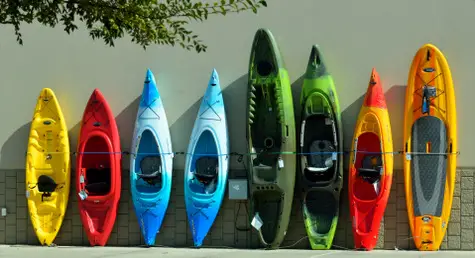Everything You Need To Know If You Want To Start Kayaking
We could all use a bit of time in nature to get away from all the stresses that are currently going on right now. There’s no denying the fact that water can have a calming effect and studies have shown that spending time near bodies of water and actually having contact with water can greatly improve both our mental and physical health.
One of the most relaxing ways to enjoy the water outdoors is kayaking and it just so happens to be one of cheaper water recreation activities there is, making it affordable to nearly everyone. Whether you enjoy getting out in nature, doing a bit of fishing, or simply want a fun new way to exercise, kayaking may be the perfect activity for you to get into.
Kayaking is great on the soul and a great activity if you happen to have a leg injury or disability. It can also do wonders for strengthening your core and upper body. While it may seem a bit overwhelming for some to know where to start when thinking about taking up kayaking, we’ve created a helpful guide to get you started out on the right paddle. Here is everything you need to know if you want to start kayaking.


Getting a Kayak
It’s pretty obvious that you’re going to need a kayak if you want to take up kayaking, but this isn’t as easy of a task as you might think. There are many different types of kayaks on the market and they key is knowing which one will suit your needs. A great place to start when researching kayaks is to go online to search websites that specialize in kayaks like www.paddlingspace.com where you can research the latest kayak models out there and read reviews that will help you choose the model that is right for you.
As we said, there are many different styles of kayaks, each having a different shape, size, and purpose. You may first want to consider what your transport options are as this may limit the type of kayak you can purchase. You may need to acquire roof racks for your vehicle unless you have a van or pickup truck, or may need to opt for something like an inflatable kayak if you have a really small compact car.
There are both sit-in and sit-on kayaks. Sit-in kayaks are great for paddling on cold waters as you are less likely to get wet, especially when you attach a spray skirt over the cockpit where your legs and lower body will be placed. Sit-on kayaks are great for beginners as they tend to be more stable, are much easier to paddle, and allow you to get back on easier if you should happen to capsize. They are often used during summer when the water is warmer since you are more apt to get wet.

You then have inflatable kayaks which can be easily transported in the trunk of a car and simply inflated when you reach your destination with either an electric or foot pump. They also make similarly portable kayaks that are foldable or break into smaller sections. While they may be meant for calmer water and not as durable as hard kayaks, inflatable kayaks are still often made of puncture resistant materials like rubberized nylon.
Other styles of kayaks include very long touring kayaks designed for long journeys on the water and similar but more specialized sea kayaks that can stand up better to larger waves. They have whitewater kayaks designed for adrenaline seekers looking to tackle rapids as well as fishing kayaks that are often equipped with pontoon stabilizers and can be powered by foot pedals to free up your hands for casting a line and reeling in a big catch.
It’s not a bad idea to rent a few different kayak styles to see which works best for you before you decide to purchase one, and if you are wishing to kayak with a close friend or partner you may want to look into getting a tandem kayak which can accommodate two people.
Kayaking Safety
While kayaking is often calming and enjoyable, there are safety issues to be aware of to make sure you don’t put yourself or others in harm’s way. The number one thing that can literally save your life is wearing a personal flotation device (PFD). You’ll want to make sure to get a PFD that is approved for the body of water you’ll be kayaking in. Some PFDs are only suited to calm waters while others are designed to keep you safe in rough seas. It may even be a legal requirement for you to wear a PFD, so put one on to avoid a fine and potentially save your life.
Beginner kayakers will also want to be sure to learn the basics of kayaking. Read up on articles and maybe watch Youtube tutorials on how to kayak or join a kayaking course where experienced instructors can show you the easiest way to get into and remain upright in your kayak as well as proper paddling techniques. They may also be able to instruct you how to properly attach your kayak to your roof racks so it doesn’t become detached while driving and cause an accident.
Be sure to watch the weather closely before heading out to kayak. You don’t want to be caught out in heavy rains, winds, or waves. If the water you are kayaking in is quite cold, you may want to wear a wetsuit to prevent hypothermia should you end up capsizing.
Learn how to take on wakes created by large passing boats and keep an eye out for fishing lines and logs or other debris that may be just under the water’s surface in your path. Always pack enough food and water to accommodate your journey, bring some type of GPS to avoid getting lost, and have your phone with you in case of an emergency.


Essential Kayaking Accessories
You’ll need more than just a kayak to go kayaking, at least if you want your experience to be enjoyable anyway. The first obvious thing you’ll need is a paddle and what paddle you should get will depend on factors like your height, kayak width, and kayaking activity you’re planning on enjoying the most.
Keep your electronics like your smartphone, spare clothes, and other goods you wish to remain dry in a specialized waterproof dry bag that will protect your belongings even if water splashes in your kayak or you capsize. Keep yourself dry in a sit-in kayak by investing in a sprayskirt or spraydeck. And if you’re planning a multi-day kayaking trip or tour, investing in a good quality tent that you can easily take with you will go a long way to ensuring you get a good night’s sleep between each day on the water.
Protect yourself from the harsh rays of the sun by wearing sunscreen, a wide brimmed hat, and polarized sunglasses. Kayaking gloves can help protect your hands from getting blisters and maybe get a comfortable seat cushion and backrest to save yourself from back pain. Further save your back by purchasing a kayak trolley so you don’t have to carry your kayak to the water’s edge.


Kayaking Techniques
When you’re just starting out, choose a calm body of water during mild weather to test out your kayaking technique. Kayaking shouldn’t be overly difficult in calm conditions unless you’re not using proper technique. Using the proper kayaking techniques will result in expending the least amount of energy and save your body from soreness later on.
When gripping your paddle, you want to use a light grip that sees your hands about shoulder width apart and each placed equidistant from the center of the paddle. The two blades of kayak paddles have a convex (rounded outward) side and a concave (hollowed out) side. The concave side should always be facing towards you in order to propel yourself forward. The straight edge of each blade should be closer to the sky and the tapered side closer to the water’s surface.
When getting in your kayak, get in while your kayak is banked on the shoreline and then push off with your paddle to launch the kayak fully onto the water. When it comes to paddling, your paddle should enter the water at 90 degrees to the kayak. Each hand will alternate going forward and backward and only one paddle blade will enter the water at a time as you pull it through the water from in front of you and back towards you.
Simply moving forward requires small shallow strokes while more sweeping strokes will be needed to make large turns. In order to go straight, you will want to try your best to exert the same amount of force from each arm as you pull each paddle blade on either side of you through the water. Having too strong a stroke on one side will force your kayak to turn.
And try not to lean forward too much or you’ll get a sore back. Try your best to keep your back comfortably rested against the seat backrest. Paddling will become easier as you develop more arm and core muscles.


Where to Begin Kayaking
The best place to start kayaking is in your own local area. If you happen to live on a lake, then you’re set, however, most of us will have to drive to a nearby body of water. We recommend you start out on calm water like a small lake as opposed to a river which may have strong currents. Waterways near the coast can also be affected by large tide swings which can prove very difficult to paddle against an incoming or outgoing tide.
You should research where all the possible boat ramps or easiest places to launch your kayak are in your area. Many will have nice parking lots with public bathrooms you can use. Keep in mind you may need to pay for parking and may be required to purchase a permit for your kayak. Permit requirements will vary by location and some regions may even require that you have taken a basic kayak safety and paddling course.
Kayaks are often classified as a vessel and you may be required to follow marine legislation. Never kayak in areas that are marked as unsafe or prohibited. You may want to join a local guided kayak tour first where you can gain a few pointers and maybe learn where the best local spots are to check out.



















